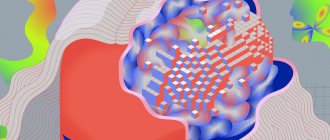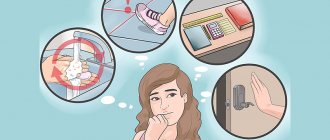: Reading time:
Psychotherapist and clinical psychologist Yulia Khvorova answers common questions about bipolar affective disorder (BAD).
In this article, I tried to answer the questions that clients with newly diagnosed bipolar disorder ask me. I will try to answer simply and clearly, based on scientific facts and information that I received during practical work with BAR.
What symptoms are used to diagnose bipolar disorder? How does the disease manifest itself?
Bipolar disorder is characterized by severe mood swings. The mood for several months, weeks or (less often) for several hours “goes to extremes” - it becomes too cheerful and too bad.
The mood for several months, weeks or (less often) for several hours “goes to extremes” - it becomes too cheerful and too bad.
Mania or hypomania is an elevated mood and violent physical and mental activity. Mental activity becomes heterogeneous - attention captures every detail, but it is difficult to concentrate on one thing for a long time. Thoughts are constantly “jumping”, one idea is quickly replaced by another. All emotions intensify: joy - to euphoria, irritation and resentment - to aggression, suspicion - to paranoia. Physical activity also increases: you almost don’t want to sleep (three hours of sleep seems enough), sexual desire increases. Behavior becomes impulsive, reckless, sometimes even adventurous and eccentric. A person can become obsessed with an idea. During a manic episode, delusions and hallucinations may occur.
Hypomania is liked by everyone who has experienced it at least once. With hypomania, unlike mania, delusions or hallucinations occur less frequently, criticality remains, and aggression is lower. However, hypomania is not a normal mental state; the brain works in an enhanced mode. Reserve resources are used to speed up mental processes, and when they run out, complete exhaustion occurs. With hypomania, the psyche seems to be running a sprint. Imagine if you only run all your life - your body will quickly deplete and wear out. It’s the same with the psyche. Hypomania can develop into more unpleasant states - mania or depression.
Reserve resources are used to speed up mental processes, and when they run out, complete exhaustion occurs. With hypomania, the psyche seems to be running a sprint.
Another sign of bipolar disorder will be not just a bad mood, but depression, from mild short-term to severe long-term. Here everything is the other way around. Activity drops: when you need to do something, there is neither strength nor desire. Mental activity is even more difficult: in addition to the lack of desire and strength, it is difficult to concentrate, remember, analyze, and make a decision. The experience of emotions becomes dull, with the exception of worsening resentment, guilt, hopelessness, confusion, anxiety or indifference. Appetite changes, insomnia or excessive sleepiness appears. Even if you are a very cheerful person, severe depression can cause suicidal thoughts. With severe depression, delusions and hallucinations may occur.
These phases can replace each other and can appear simultaneously. For a long time, only one pole can manifest itself - then even doctors, instead of correctly diagnosing “BAD,” may first diagnose “depression.” The breaks between episodes (intermissions) are different for everyone - it can be a month, a year, three years, five years.
In a healthy person, changes in the activity of mental processes are not so contrasting and are more amenable to regulation. They do not lead to a deterioration in everyday functioning - a person can successfully cope with the professional and academic responsibilities assigned to him, and establish and maintain relationships with others.
Bipolar disorder. A survival guide for those who often cannot see the white line
LIFE ON A ROLLER COASTER
“I am a person of mood. When I'm in the mood, I can move mountains. When I don’t, I can’t even bring myself to wash my hair.”
“It’s very difficult for me to plan anything because I don’t know what I’ll be like in at least a week. Maybe a superhero, maybe a pathetic loser."
“Even when I’m in a calm mood, I’m worried: it could end any day.”
“I am an enthusiastic person: I often come up with and start something new, I immerse myself in it headlong. And then I run out of energy, I give up everything, and it’s unpleasant to even remember my previous hobby.”
“My life seems to go in a circle: a rise when I achieve everything, then a decline when I lose almost everything, and each time I have to start all over again.”
“It’s as if two or even more personalities live inside me, they have different characters, different interests, and they look different.” “Everything with me is either too wonderful or completely terrible, everything with me is too much.”
“I don’t need doping, it’s like my brain produces drugs on its own.”
“The ups wear me out, and the downs drain me. I don’t know if my life is ever normal?”
“I don’t even know who I really am.” “My life is complete chaos.”
This is how people with bipolar disorder describe themselves and their lives. If you recognize yourself, someone close or familiar, then you have chosen the right book! This is the first guide to surviving bipolar disorder in Russia. In it we have collected relevant and practical information about bipolar disorder and how to organize your life with this feature. In the first part of the book we will tell you what bipolar disorder is and what it looks like from the inside and from the outside.
What is bipolar disorder
Bipolar affective disorder (abbreviated as bipolar disorder, code F31 in the International Classification of Diseases, 10th revision and 6A60 in the future ICD, 11th revision) is a chronic mental illness in which periods of normal mood alternate with episodes of increased (hypomania and mania) and decreased (subdepression). and depression) mood.
Between episodes, the person usually recovers completely. Episodes are also called phases or attacks of illness, and the periods of a healthy state between them are called intermissions, light intervals or euthymia.
Bipolar disorder is classified as a mood disorder, as are various types of depression. This means that it manifests itself primarily in disturbances in the emotional sphere.
Bipolar disorder does not lead to personality degradation, does not reduce mental abilities, and does not deprive a person of legal capacity. But at the same time it is considered a serious illness from the field of “big psychiatry” on a par with schizophrenia, and one of the most dangerous due to the high suicidal risk.
To understand why mood disorders are dangerous, let's remember the role emotions play in our lives. Mobile and changeable emotions have an extremely important function: they help to quickly navigate in any situation and respond adequately to it.
The prevailing emotions in a person form the mood - that is, the general emotional background. It depends not only on external events, but also on temperament. For example, a sanguine person (who is called hyperthym in modern psychology) has a heightened emotional background; he will react to any events more positively and energetically than, say, a phlegmatic person.
Emotions play a key role in communication, warning us of danger, and also “rewarding” or “punishing” us for actions that we consider right or wrong. We even think thanks to emotions: intuition, insight, creative inspiration - all this is the result of the work of emotions.
As noted emotion researcher Paul Ekman, emotions motivate our lives and determine the quality of our lives. After all, we evaluate various events, the people around us and our lives in general not by some objective criteria, but by the emotions that all this evokes in us. Some psychologists believe that people make almost all decisions at the level of emotions, and the mind only rationalizes them. Emotions can be even stronger than basic instincts: hunger, sexual desire and the desire to survive.
Now imagine that the response system carefully balanced by nature is broken. Emotions stop reflecting the surrounding reality and begin to live their own lives.
For example, everything is going great for you, you graduated from a prestigious university, and received several promising job offers. But you are not interested in anything. You hate yourself and your life and only want to be left alone. Or, on the contrary, you were fired from your job, broke up with your loved one, but there is a feeling of celebration in your soul, and you take out a loan to continue having fun.
If you are stuck in one state or another for a long time, if the strength and duration of emotions are not related to life circumstances, you can talk about a mood disorder.
Mood can be chronically low, even when everything is great, or high, despite many problems. Or it may be that throughout life, cycles of extremely good and extremely bad moods alternate, as happens with bipolar disorder.
There is no single picture of bipolar disorder. The phases can alternate at different frequencies and in different orders. The combination and strength of symptoms also varies from patient to patient. For example, someone develops one hypomania after several depressions. For some, episodes are isolated, and between them there are years of remission. And there are bipolar people in whom mania and mixed states predominate (in which symptoms of mania and depression are present simultaneously), but there is almost no depression.
It's fair to say that every bipolar person is bipolar in their own way. As a rule, in the life of one person a typical set of symptoms is repeated.
Bipolar disorder is currently considered an incurable disease. This means that ups and downs can be repeated throughout life. Their frequency and severity can be reduced with the help of medications, but the therapy available today does not guarantee complete relief from symptoms.
The treasured word “remission”
The long-term absence of mania and depression is called remission. It can occur spontaneously, but most often due to long-term use of medications. Remission can last for several months or several years, and in some lucky cases it lasts for life.
It is not always possible to adequately assess your own condition, so if you want to make sure that you are on the mend, find out the opinion of your doctor. Quite often, bipolar people mistake hypomania for recovery.
What are the chances of going into long-term remission with bipolar disorder, that is, becoming a virtually healthy person again?
There is no clear answer to this question, since remission depends on many factors. We will present the most basic ones.
1. A well-chosen treatment regimen. Statistics show that mood stabilizers used to treat bipolar disorder improve the condition of 70–80% of patients. It has been proven that they can extend the life of a person with bipolar disorder by several years and significantly improve its quality.
2. Length of illness. The sooner a person receives a correct diagnosis and begins treatment, the greater his chances of remission. And, on the contrary, the more manias and depressions he has experienced, the more difficult the future prognosis.
3. Lifestyle. In the following chapters, we will examine in detail which habits and skills help maintain balance, and which, on the contrary, put it at risk.
In addition to clinical remission, which implies the absence of symptoms, there is also the concept of “functional remission”. It means returning to healthy functioning as a member of the family, community, professional, and so on (depending on what is important to the individual). Functional remission depends not so much on pills, but on psychological conditions: can a person organize life taking into account his limitations, build a regime, are there people around who are ready to support him.
On the one hand, many bipolar people are able to maintain high functionality even in the presence of symptoms. On the other hand, each attack of acute mania or depression unsettles a person for a long time, and it often takes months to recover psychologically. Psychotherapy can help with this process.
It is important to consider that remission must not only be achieved, but also maintained. A person with bipolar disorder remains more vulnerable to stress throughout their life than someone without it. In addition, many people continue to have so-called “residual symptoms” - periods of depression, irritability, anxiety, and decreased mental abilities. Therefore, balance, if you managed to achieve it, must be carefully preserved, and not test the strength of your psyche. In particular, a chaotic lifestyle and substance abuse increase the risk that mania and depression will return.
Just the facts
The first symptoms of bipolar disorder appear at a young age: in more than half of cases - before the age of 18, in the vast majority of cases - before the age of 30.
Most often, the first episode of the disease occurs at 15–25 years of age. Moreover, the earlier the disease begins, the more severe it is. Bipolar disorder can manifest itself in both childhood and old age, but this occurs quite rarely.
As a rule, the disorder begins with depression, although in men hypomania often occurs first.
On average, one person experiences 10 episodes in his life (if untreated). But with a rapid change in cycles of disease attacks, there can be more than 50.
Bipolar disorder often leads to disability and disability. Globally, according to the World Health Organization (WHO), it is the 12th most common cause of disability. More people become disabled due to symptoms of bipolar disorder than due to asthma, and almost as many as due to coronary heart disease.
Due to the difficulties of diagnosis, even in Europe, people find out their diagnosis only 10 years after the initial visit, which, of course, prevents timely treatment.
How many bipolar people are there in the world?
This is a less common disorder than depression, but still not uncommon.
Most studies in the 80s and 90s showed that it affects 1-2% of all people.
Modern studies, which use more subtle diagnostic methods and take into account relatively mild forms, show impressive figures - more than 5% for bipolar spectrum disorders.
The prevalence of bipolar disorder type I is about 1% of the population, type II is about 1.5%.
Statistics for different countries vary greatly. Most likely, this is largely due not to the prevalence of the disease, but to the characteristics of the healthcare system and the collection of statistics.
If we look at the available data, we see two poles: the most diagnosed bipolar people are in the USA (4.4%, that is, more than four people out of 100), the least in Russia (0.036%, or less than one person in ten thousand!) .
In the analytical review of the Ministry of Health for 2011 (newer data is not yet publicly available), only 8,700 people were registered with a diagnosis of bipolar disorder throughout the country! At the same time, the number of patients with schizophrenia, which is considered a rarer disease, exceeds 500 thousand.
This speaks to at least two features of domestic psychiatry: firstly, state psychiatric hospitals (data from private clinics are not included in official statistics) diagnose bipolar disorder much less often than they should. Secondly, most bipolar people never seek treatment.
Risk of suicide
Bipolar disorder is considered one of the most dangerous mental illnesses. Between 20 and 60% of bipolar people have attempted suicide. From 4 to 19% (according to various studies) died for this reason. This is more common than in chronic depression or schizophrenia.
The risk of suicide exists with depression of any severity, because each person has his own limit of ability to endure suffering. But there are factors that significantly increase the danger. This is, according to research:
• Disease phase . The most dangerous periods are considered to be psychotic depression and mixed states, especially at the end of a depressive episode: in these states, thinking is focused on the negative, but at the same time there is strength to plan and commit suicide.
• Dual diagnosis . A dangerous combination is bipolar and borderline disorder (BPD) in one patient. Such people are prone to self-harm, impulsive and destructive behavior, especially under stress. At the same time, due to the demonstrative nature of “border guards,” loved ones often do not take their threats seriously. The combination of bipolar disorder with alcohol or drug addiction also increases the risk of suicide.
• Suicide of a loved one . A family history of suicide or the recent suicide of a friend significantly increases the risk. This is a scenario that can repeat itself.
• Gender and age. Men are more likely to die from suicide than women. But women are more likely to make attempts, including with serious health consequences. At risk are adolescents and young men whose symptoms appear for the first time. They have neither the experience nor the understanding of how to deal with it.
Bipolar disorder or manic-depressive psychosis?
Many people have heard the expression manic-depressive psychosis (MDP). And those who were treated during the Soviet era have exactly this diagnosis. BID is an outdated name for bipolar disorder that is still sometimes used today.
Used in Europe and Russia, ICD-10 replaced this term with BAR in 1989. The term was considered incorrect because it stigmatizes patients and at the same time inaccurately characterizes the disease itself.
As it turned out, bipolar disorder does not always develop psychosis, and in many cases there is no mania.
There is still ongoing debate among doctors and patients about which name is more appropriate. Clinical psychologist Kay Jamieson and author Stephen Fry prefer the term "manic-depressive illness" because they believe it more accurately conveys the essence of the disorder.
What are the causes of bipolar mental disorder?
Unfortunately, science cannot answer why bipolar disorder occurs. What is known is that many factors interact with each other.
Now the occurrence and development of the disease is considered through the biopsychosocial model (BPSM). According to this model, the development of the disease is influenced by three factors - biological, psychological and social.
The biological factor includes genetics, physiological and biochemical characteristics of the body.
Psychological factors in the development of bipolar disorder include the number and intensity of stressful experiences, coping strategies, character traits, emotional sphere, and thinking.
Social factors - cultural and political situation, economic situation, microsocial environment (family, friends, professional environment, acquaintances).
The emergence and development of bipolar disorder is not caused by one of these factors, but is a consequence of their interaction.
Unfortunately, science cannot answer why bipolar disorder occurs. What is known is that many factors interact with each other.
Questions like “Why me?”, “What causes BAD?”, which cannot be answered, are called rumination. The thought chains that arise when thinking about such questions do not lead to an answer, but lead to a decrease in mood, increased anxiety and a feeling of hopelessness. Psychotherapeutic techniques and communication with loved ones will help you switch or abstract from such thoughts.
Can you self-diagnose bipolar disorder?
Mindfulness is one of the main ways to prevent most mental disorders. To be able to track the traps that our brain builds, you need to know which thinking techniques are the most resourceful and effective, and which can lead to a dead end. By the way, our online program “Cognitive Science” will help you with this, providing a detailed algorithm for dealing with this kind of traps.
Only a qualified psychiatrist can make a diagnosis of bipolar personality disorder. However, if you have any doubts about your own mental and emotional state or the state of your loved ones, you can make a small diagnosis using a small test.
We present to your attention a number of questions, which should be answered in monosyllables and without much thought:
- Do you have contrasting mood swings: from intense sadness to excessive joy?
- Do you ever have times when you can't control your thoughts because they are changing quickly?
- Do you have unreasonable attacks of anger?
- Do you become suspicious or hostile for no apparent reason?
- Do you tend to be too talkative?
- Do you feel like you can work non-stop and continue to work late into the night despite a hard day at work?
- Have you felt excessive joy for no reason for 3 or more days in a row?
- Have you ever done rash, impulsive things (for example, large financial expenses or risky activities)?
- Do you ever have times when you are unable to concentrate on daily tasks for a long time?
- Do you ever have periods when you can easily sleep 3-5 hours a night and feel great?
- Do you ever go through periods when you sleep 10 hours a day and still feel groggy?
- Do you ever have times when you feel overconfident for no apparent reason?
- Do you ever go through periods when you feel too sorry for yourself?
- Do you ever have periods when your appetite changes suddenly and for no reason?
- Do you ever go through periods when you lose interest in things or activities that used to bring you great joy?
Of course, this test cannot speak with certainty about any disorders. But if you or your loved ones answered yes to half or more of the questions, you should consult a specialist to eliminate the risk of developing any cognitive disorders.
How is bipolar personality disorder treated? Will I be in a mental hospital?
The need for hospitalization may not arise if you take a responsible approach to treatment. If left untreated, episodes of mania and severe depression are likely to result in hospitalization. However, hospitalization does not put an end to a person’s life, but helps to get out of an episode of depression or mania and return to normal life.
As mentioned earlier, the course of bipolar disorder is influenced by three factors - biological, psychological and social. To minimize the impact of bipolar disorder on your life, you need to take control of all three factors. In this case, you will not have to go to the hospital and outpatient treatment will be sufficient.
The biological factor will be taken over by medications and a healthy lifestyle. A psychiatrist will prescribe the necessary medications for you. The medications must be taken regularly; you should not pause without consulting your doctor. If you experience unpleasant side effects, discuss this with your doctor and decide together whether to wait, change the dosage, or switch to another drug.
A healthy lifestyle helps maintain the normal state of all body systems, including the nervous system. Taking medications will not have a good effect if drugs or alcohol are simultaneously affecting the brain. The following will help you maintain your nervous system, and therefore all mental activity, in good condition: stable good sleep (at least seven hours), absence of bad habits (alcohol, drugs, smoking), regular physical activity, proper rest, adherence to a daily routine, proper nutrition.
The medications must be taken regularly; you should not pause without consulting your doctor. If you experience unpleasant side effects, discuss this with your doctor and decide together whether to wait, change the dosage, or switch to another drug.
Psychotherapy will help regulate and take control of the psychological factor. The recommended type of psychotherapy for bipolar disorder is cognitive behavioral therapy (CBT). Psychotherapy will not cure the disease, but will allow you to develop problem-solving skills, effective communication, and coping strategies. New skills or habits will help you cope with stress and anxiety, and resolve intrapersonal conflicts. At the end of psychotherapy, you will be able to independently apply these skills in life. Depressive episodes will be easier to experience, and their consequences will no longer be so severe. Psychotherapy promotes the development and harmonization of personality, which prevents the occurrence of certain stressful situations (conflicts, destructive relationships).
The social factor in the development of bipolar disorder is relationships with loved ones, work or study, social activity. The support of relatives and friends has a positive effect on the psychological state and helps to cope with episodes more easily. Stable work is also important, not only to ensure economic stability, but also to maintain a daily routine, expand your social circle, and feel important and needed. Spending time with friends and comrades has a positive effect, brings positive emotions, and distracts from sad thoughts during a depressive episode.
I would like to summarize the above about the treatment of bipolar disorder:
When to contact a specialist
Consultation with a psychiatrist-psychotherapist is necessary if the following symptoms are present, provided that they are permanent:
- Sudden changes in mood from a state of euphoria to complete despondency or aggressiveness and irritability.
- Painfully inflated self-esteem.
- Changes and sudden changes in energy levels.
- Excessive, previously unusual activity.
- Change in speech habits: begins to talk a lot, speech is accelerated, sometimes slurred, quickly jumps from one topic to another, without taking into account the reaction of the interlocutor.
- Use of drugs or alcohol.
- Sexual activity.
- Depression, depressed mood, tearfulness.
- Isolation, reduction of social circle, narrowing of interests.
- Feelings of guilt, feelings of uselessness and worthlessness.
- Suicidal thoughts or conversations, self-destructive behavior.
It is worth considering that bipolar disorder is highly treatable. As a rule, the first diagnosis is made by a psychotherapist, to whom parents turn in the event of alarming symptoms and painful changes in the child’s behavior and habits. In the future, a consultation with a psychiatrist and, in most cases, the prescription of drug therapy are also necessary.
A child or adolescent needs the help of a psychotherapist at all stages of treatment for bipolar disorder, but especially at the rehabilitation stage.
The specialist will help the patient adapt faster and select treatment methods that reduce the risk of relapse.
Reminder for the treatment of bipolar affective disorder (BD)
Control of biological factors:
- See a psychiatrist (at least once every three to four months);
- Take medications prescribed by a psychiatrist;
- Lead a healthy lifestyle;
- Set a daily routine.
Control of psychological factors:
- Accept yourself with bipolar mental disorder;
- Take a course of psychotherapy;
- Apply independently acquired skills to prevent and resolve stressful situations;
- If possible, minimize the number of stressful situations.
Control of social factors:
- Help and support of family members;
- Stable and feasible work;
- Communication, spending time with friends and acquaintances;
- Social activity, expanding the circle of acquaintances.
This memo clearly shows that you yourself can do a lot to improve your condition. Almost everything depends on you.
Remember: when protective factors outweigh risk factors, this is a good tool for reducing the frequency and intensity of episodes.
How will bipolar disorder affect my life?
If a patient with bipolar affective disorder takes pharmacotherapy and follows the rules for preventing episodes, the number and intensity of episodes is reduced to a minimum, and in intermissions there are no symptoms at all. Under these conditions, bipolar disorder does not have a significant impact on life.
Bipolar disorder, like any chronic disease, makes changes to your routine: systematic visits to the doctor, taking medications, and preventive measures.
If bipolar disorder is left untreated, episodes will significantly impact work and personal life.
Bipolar disorder, like any chronic disease, makes changes to the regime: systematic visits to the doctor, taking medications, preventive measures.
During the hypomanic and manic phases, mental and physical activity increases, but becomes impulsive and chaotic. The work will be easy, but it will not bring results. You will be able to do many things at the same time, but none will be completed. Hostility and aggression arise towards close people, which gives rise to conflicts. Without malicious intent, you can offend loved ones and not even notice it, quickly switching to something else. A manic episode may be accompanied by delusions and hallucinations, increasing the likelihood of hospitalization.
During a depressive episode, there is neither the desire nor the strength to do anything, so work and study will be difficult. Severe depression forces you to take a leave of absence from your studies or leave from work. In relation to close people, indifference, touchiness and isolation appear.
In addition to what has already been said, such “swings” tire not only you, but also the people around you. For the employer, this is an unstable employee who cannot be relied upon. For loved ones (especially if they do not know about the diagnosis of bipolar disorder), unpredictability of mood causes emotional stress, which leads to misunderstandings and conflicts.
Treatment of affective bipolar disorder
The development of a course of treatment for bipolar disorder is carried out by a psychologist or psychotherapist. An individual program is drawn up for each patient, which takes into account:
- patient's age, gender;
- frequency of attacks, duration of remissions;
- present concomitant diseases;
- type and phase.
Like other affective disorders, the prognosis for the development of the disease is initially difficult to predict. The doctor develops a treatment option, checking which medications and psychological practices help the patient.
Bipolar disorder in adolescents
Bipolar disorder in adolescents is difficult to diagnose. Its manifestations may be similar to teenage whims associated with hormonal changes. Some experts suggest the presence of symptoms of bipolar disorder at the initial stage in almost half of young men and adolescent girls. About 1.5% of young people are formally diagnosed.
Therapy is based on correcting the disorder primarily through psychological training and sedative medications. It is recommended to take B vitamins that strengthen the nervous system.
According to indications, it is recommended to prescribe antipsychotics, mood stabilizers, antidepressants, and sedatives. The use of medications in the treatment of adolescents is used in situations of recovery from an acute condition.
Bipolar disorder in women
In the fair sex, the manifestation of bipolar disorder is characterized by starting with a depressive episode. A peculiarity of diagnosing bipolar disorder in the fairer sex is the frequent failure to identify the diagnosis, the manifestation of which is associated with a naturally elevated emotional status. In an attempt to independently overcome mood swings, women often bring the disease to the stage of frequent alternation between a depressive state and manic states.
When developing a course of therapy, the need to adjust the course depending on the hormonal status of the patient is taken into account. Puberty, any termination of pregnancy (abortion, miscarriage or childbirth), menopause can provoke an exacerbation of bipolar disorder and change the symptoms of the disease. An exacerbation can provoke the simple onset of monthly menstrual bleeding.
Treatment uses a combination of atypical psychotics and mood stabilizers. The disease is often accompanied by physical pain and increased body temperature. Antipyretic and analgesic drugs are used in treatment.
Each patient undergoes a course of individual and group psychotherapy. This allows you to relieve a high degree of tension, anxiety, and reduce the level of depression.
Bipolar affective disorder in men
Considering that men more often suffer from the onset of a manic phase, preference in therapy is given to sedatives and sedatives. It is not recommended to stop using medications at the stage of relapse or first manifestation. The use of medications ensures rapid relief of an active condition that is dangerous for the patient. Further, it is recommended to prescribe medications that ensure long-term, ideally lifelong, remission.
A feature of therapy for men is the frequent refusal of patients to accept the presence of a diagnosis. Starting with a manic episode, accompanied by increased activity and performance, allows patients to simply assume that they have a colossal amount of vital energy. Most men positively accept their unexpected increased sexuality, from their point of view, additionally confirming success and strength. The lack of therapy leads to a change from a manic stage to a depressive stage with severe symptoms.
An important condition for the successful treatment of bipolar disorder in men is the joint work of relatives and doctors. This helps to seek medical help in a timely manner.
Bipolar disorder in patients of any gender is currently not completely curable. The condition must be monitored for life by a specialist. In most situations, a preventive examination, prescribed once every few months, is sufficient.
When life factors occur that can provoke a relapse, patients are advised to seek advice on their own. Provocateurs are individual for everyone. This could be a long-term stressful situation, a sad or joyful event. Patients with bipolar disorder and their relatives are advised to remember the need to promptly stop a potential exacerbation.
Will children inherit bipolar disorder?
According to the Center for Clinical Interventions, children of patients with bipolar disorder have an 8% risk of inheriting the disease. According to Bebbington (2004), the probability of inheriting bipolar affective disorder is 5-15%. At the same time, the likelihood is twice as high that relatives of bipolar patients will develop unipolar depression (that is, ordinary depression without the second pole - without mania/hypomania).
This in no way means that you shouldn’t have children. This is a reason to take care of the biological, psychological and social components of their development. Do not forget that the probability of remaining healthy in children of patients with bipolar disorder is 65-75%.
What to do if you suspect you or your loved ones have bipolar disorder?
If you notice sudden mood swings for no apparent reason, this is a reason to seriously think about it. Ten or more of the symptoms we have listed may indicate the presence of a disorder. Especially if thoughts of suicide appear from time to time.
- The first step is to see a therapist. Get tested and undergo the examination that he prescribes. Some hormonal disorders are similar to bipolar disorder - for example, diabetes, hyper- and hypothyroidism. It is important to exclude them or detect them and begin treatment.
- The second step is an appointment with a psychotherapist or consultation with a psychologist. Be prepared that the specialist will ask about your lifestyle, bad habits, relationships with people, hereditary diseases, childhood injuries and many other details.
Based on this data, you will be prescribed treatment. This could be depth psychotherapy, medication, or all three.
Do not self-medicate under any circumstances, so as not to aggravate the condition. At the moment of exacerbation, do not be alone - let one of your relatives be with you. Call a licensed psychologist, your primary care physician, call an ambulance, or go to the hospital immediately.
If your loved one is depressed, do not leave him alone. Remove all objects that can cause harm to health - from piercing and cutting objects to tablets. Persuade him to call a doctor.
How to explain to loved ones what is happening?
Society still maintains a negative attitude towards mental disorders, so it is difficult for a person with a psychiatric diagnosis to tell even close people about it. At the same time, the support of family and friends plays a very important role in psychological well-being and gives strength to cope with stressful situations.
When talking about the features and symptoms of bipolar disorder, you can always use the description of its symptoms given at the beginning of this article.
Why is it important to inform loved ones about your condition:
- Family and friends will be able to spot dangerous changes in behavior that precede episodes and advise you to make an unscheduled appointment with a doctor. The doctor will have the opportunity to adjust pharmacotherapy in a timely manner, which will reduce the duration and intensity of the episode.
- Relatives will not take the behavior during the episode personally and will be more able to tolerate hot temper, touchiness, and aggression. The number of conflicts and additional stress for you will decrease. Telling significant people about your diagnosis will help make communication with them more environmentally friendly, positive, and less traumatic.
If you don't want to explain your condition in detail, at least don't isolate yourself from loved ones. Do not create new stress for yourself in the form of conflicts and severance of relationships with family and friends. You can simply reduce the amount of communication. If you have less or less frequent contact with loved ones during an episode, this will not necessarily raise suspicion. We all go through periods of high workload and busyness. And only you can decide whether to tell someone about your diagnosis or not.
And only you can decide whether to tell someone about your diagnosis or not.
Support can be found in psychotherapy and bipolar disorder support groups. These are special groups with certain rules in which you can meet people with the same diagnosis, discuss issues that concern you about bipolar disorder, and receive understanding and support.
Clinical manifestations
Bipolar disorder begins with an acute phase of symptoms and continues through repeated courses of remissions and relapses. Remission is often complete, but many patients have residual symptoms, and some have significantly reduced ability to function. Relapses are in the nature of discrete episodes of an intense clinical picture of mania, depression, hypomania, or a combination of depressive and manic manifestations.
The duration of episodes ranges from several weeks to 3–6 months.
The length of the cycle—from one episode to the next—varies significantly among patients. Some patients have infrequent episodes, perhaps only a few over a lifetime, while others experience rapid cycling forms (usually defined as ≥ 4 episodes/year). Only a minority alternate between mania and depression each cycle; in most cases one or the other predominates to some extent.
Patients may attempt or commit suicide. The lifetime prevalence of suicide in patients with bipolar disorder is estimated to be at least 15 times higher than that of the rest of the population.
Mania
A manic episode is defined as a period of ≥ 1 week of persistently elevated, expansive or irritable mood, energy, or persistent increased goal-directed activity, with at least 3 additional symptoms:
- Inflated self-esteem or delusions of grandeur
- Decreased need for sleep
- More talkative than usual (loquaciousness)
- Flight of ideas or thoughts
- Absent-mindedness
- Increased business activity
- Excessive involvement in activities with a high risk of unpleasant consequences (for example, excessive purchasing activity, unwise financial investments)
Patients with manic disorder may actively, excessively, and impulsively participate in a variety of risky activities (eg, gambling, dangerous sports, promiscuity), ignoring possible dangers. The symptoms are so severe that they are unable to carry out their main activities (work, school, household). Unwise investments, excessive spending of money and other actions can have irreversible consequences.
Patients in a manic state may be enthusiastic, dress flamboyantly and flamboyantly, often act authoritative, and speak quickly and continuously. They tend to associate words by sound similarity (new thoughts arise in response to the sound of a certain word, and not to its meaning). Patients in this state are easily distracted and constantly move from one topic to another. However, patients generally feel that they are in their best mental state.
Lack of self-criticism and increased busyness often leads to the development of compulsive behavior, which can be a dangerous combination. Interpersonal conflicts may lead patients to feel that they are being unfairly or unfairly persecuted. As a result, patients can pose a danger to themselves and others. Active mental activity manifests itself as racing thoughts or flight of ideas.
Manic psychosis is the most striking form of the disorder with severe psychotic symptoms that are difficult to differentiate from schizophrenia. Patients may develop delusions of persecution (for example, the patient believes he is Jesus or the person the FBI is looking for), sometimes with hallucinations. The level of activity increases noticeably; patients may rush around the room and scream, swear, or sing. Emotional lability increases, often with increased irritability. Severe delirium (delusional mania) may develop with a complete loss of coherent thinking and behavior.
Hypomania
A hypomanic episode is a less severe variant of mania when a single episode lasts ≥ 4 days (with the patient's behavior being very different from behavior in a normal, non-depressive state) and includes ≥ 3 additional symptoms listed above in the description of mania.
During the hypomanic period, mood improves, the need for sleep decreases, and psychomotor activity accelerates. For some patients, hypomanic periods are adaptive because they produce high energy, creativity, self-confidence, and extraordinary social functioning. Many people do not want to lose their pleasant, euphoric state. Some functions are quite good and in most cases the performance deteriorates unnoticeably. However, some patients are characterized by poor concentration, irritability and emotional lability, which causes some discomfort to the patient and others.
Depression
A depressive episode has features characteristic of major depression; The episode must include ≥5 of the following symptoms over the same two-week period, one of which must be depressed mood or loss of interest or pleasure:
- Depressed mood most of the day
- Marked decrease in interest or enjoyment in all or almost all activities for most of the day
- Significant (> 5%) weight loss/gain or loss/increase in appetite
- Insomnia (often associated with inability to stay asleep) or hypersomnia
- Psychomotor agitation or retardation observed by others (not self-reported)
- Fatigue or loss of energy
- Feelings of worthlessness or excessive or unreasonable guilt
- Decreased ability to think or concentrate, or indecisiveness
- Recurrent thoughts of death or suicide, suicide attempts, or specific plans to commit suicide
Psychotic features are more common in bipolar depression than in unipolar depression.
Mixed signs
An episode of mania or hypomania is said to be mixed if ≥ 3 depressive symptoms are present on most days during the episode. This type of disorder is often difficult to diagnose and may be hidden behind a persistent cyclical condition; the prognosis is worse than in pure manic or hypomanic states.
The risk of suicide during mixed episodes is especially high.
Where to go for advice and help?
There are different options for receiving psychiatric and psychotherapeutic help.
State psychiatric hospitals and psychoneurological dispensaries at the place of residence.
Crisis helpline - you can call if you are having suicidal thoughts. Phone: 8 (800) 100-49-94.
Private clinics licensed to provide medical care. The authenticity of a license can and should always be checked on the website of the licensing authority. Do not forget to check the authenticity of the education of the specialists you contact.
No one option can guarantee the best mental health care one hundred percent. If you have doubts or discomfort, you can always change your doctor, listen to several opinions and try different treatment options. A good specialist will always be able to talk about the diagnosis and course of treatment, and will back up his words with data from modern research. The choice is yours.









